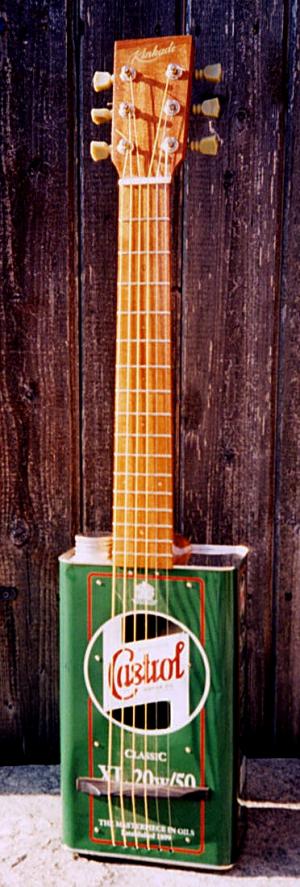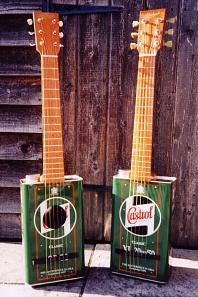
Or, if you prefer, the Kinkade Stratocastrol, the Lubricator, the TinTone, the Twang Can, the Tank - whichever name applies, this is actually a for-real medium scale acoustic guitar with a remarkable sound.
When I visited Jonny Kinkade's Bristol workshop one day last summer, he had on the bench a rusty old tin can, with a hole cut in the top and a wooden neck with six strings attached sticking out one end. It had the most amazing sound, somewhere between a Dobro guitar, a banjo and a mandolin, and I asked him where he'd got the idea for it. He told me he'd been invited to a recital at a local school where some visiting African children had performed, using four-stringed tin-can guitars with broomstick necks. The sound they made as an ensemble was apparently so extraordinary that he set his mind to making one himself, refining the basic principle by adding a proper, fretted guitar neck, albeit in a 22½" medium scale.

Basic construction is fairly straightforward. Once the handle of the can has been removed, the top is split centrally and cut open to allow the mahogany neck to be inserted. It's then glued inside and fixed to the tin using three screws at the rear and two on top. To prevent the can from buckling, two strips of wood are fitted lengthways beneath the top, fixed by eight screws. This also provides a platform for the carved rosewood bridge. The strings pass through six holes punched in the top and base of the can, anchored by a rosewood block at the rear. The sound-holes on my guitar were cut around the Castrol flash, but on Andy's guitar it's a simple round hole, to allow fitting of a pickup if required. I also know of his feelings toward advertising!
The sound you get from this guitar depends on how you hold it, and where you pick the strings. Held away from the body, the can is free to vibrate fully and gives out a loud, metallic twank, particularly so when picked near the bridge; think of the riff from Missy Elliot's "Get Ur Freak On"! It gets warm and mellow nearer the end of the neck, and quieter if hugged by the player, when it sounds akin to a muted, 6-string mandolin. A capo fixed halfway up the neck takes it into another dimension again, and is particularly effective. Though versatile, I imagine the Can would present problems on stage as it's an awkward thing to fix a strap to, and the neck is heavier than the "body"! I'm still working on a playing technique that's comfortable - it'll come with practice, I'm sure…
Hope you've enjoyed looking at this year's "Picks" as much as I've enjoyed playing 'em. Have a great holiday season - see you back here next year!